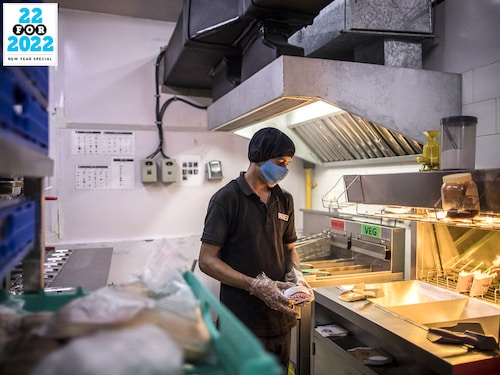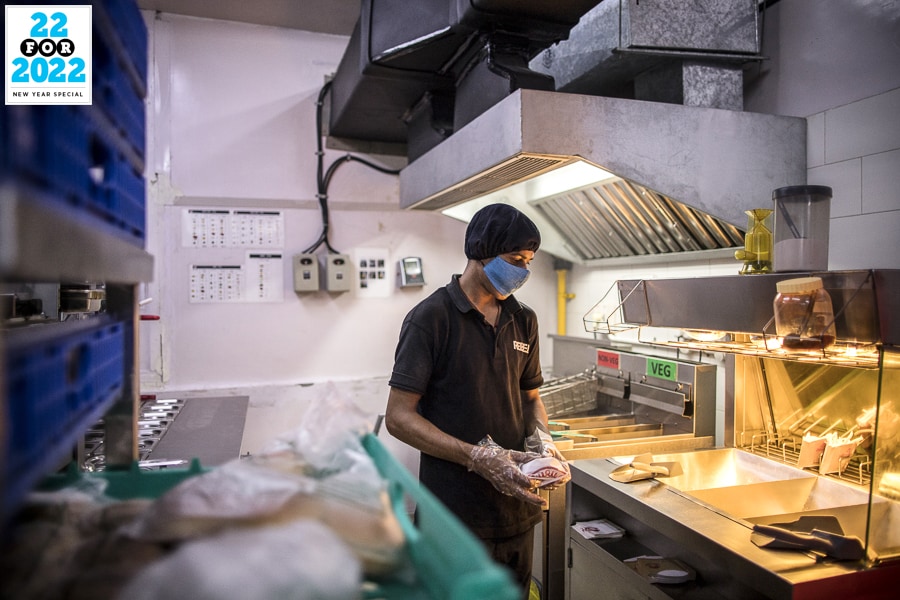Why cloud kitchens need to scale up smart, not fast
Technology, customer experience, and a streamlined supply chain are the key differentiations for a delivery kitchen to thrive or lose its foothold in a crowded space


 Cloud kitchen model also reduced the cost of starting up a food brand, and many first-time restaurateurs embraced the model. However, only a few managed to survive and scale with the model during the period
Cloud kitchen model also reduced the cost of starting up a food brand, and many first-time restaurateurs embraced the model. However, only a few managed to survive and scale with the model during the period
Image: Bloomberg/ via Getty Images
 The way we eat from restaurants has fundamentally changed in the last couple of years, and that has thrown up a lot of questions for the industry. Earlier, most restaurants would see a small part of their business coming from delivery. Today, most of the established restaurants see an increasingly higher share—even the majority share in many cases—coming from customers ordering in. In the new normal, the Indian foodservice delivery market is expected to double in value to $13 billion by 2025 (according to a RedSeer report), growing over 30 percent CAGR between 2021-26 (according to a report by Motilal Oswal Financial Services), growing much faster than the overall industry (including dine-in). This changing trend has also led to the rise of ‘cloud kitchens’. According to a report by RedSeer Management Consulting, cloud kitchens are set to be a $2 billion industry in India by 2024, up from $400 million in 2019.
The way we eat from restaurants has fundamentally changed in the last couple of years, and that has thrown up a lot of questions for the industry. Earlier, most restaurants would see a small part of their business coming from delivery. Today, most of the established restaurants see an increasingly higher share—even the majority share in many cases—coming from customers ordering in. In the new normal, the Indian foodservice delivery market is expected to double in value to $13 billion by 2025 (according to a RedSeer report), growing over 30 percent CAGR between 2021-26 (according to a report by Motilal Oswal Financial Services), growing much faster than the overall industry (including dine-in). This changing trend has also led to the rise of ‘cloud kitchens’. According to a report by RedSeer Management Consulting, cloud kitchens are set to be a $2 billion industry in India by 2024, up from $400 million in 2019.
Internet, ghost, or cloud kitchens are, in their essence, establishments that do not have the physical capacity to serve walk-in customers and are exclusively focused on delivery orders. The model has many benefits—it minimises rentals, needs less capital expenditure to set up, and requires less manpower and overhead costs to run, as compared to a dine-in restaurant. Because of these inherent advantages, many restaurants moved to the cloud-kitchen model over the last few years. The model also reduced the cost of starting up a food brand, and many first-time restaurateurs embraced the model. However, only a few managed to survive and scale with the model during the period.
The reason is that lower costs alone can’t guarantee success, because fundamentally it boils down to providing great customer experience in delivery and doing so consistently and efficiently. While cloud kitchens reduce running costs, they do not help in solving multiple other problems of scaling-up, which could potentially dilute consistent customer experience. For example, accurate order forecasting, dependable supply chain, effective training, quality assurance, etc. are essential to scaling, but not solved by the cloud kitchens model. So, how does one solve these issues?
The answer lies in technology. Smart cloud kitchens utilise technology to solve the above issues and help create memorable brands. There are many aspects that can leverage tech—culinary innovation and product consistency, kitchen management technology, and supply chain. At Rebel Foods as well, we’ve been focusing on building the ‘Operating System’ which allows brand-partners to not just scale up fast, but scale up smart through a tech-enabled network.
The pandemic accelerated a couple of relevant trends which were already happening pre-Covid: The transition to digitization and the focus on innovation to improve experience and efficiency. For example, food products in a kitchen have a limited shelf life and yet speedy execution is the key to getting food delivered to customers within 30 minutes of order placement. Hence accurate forecasting becomes important to prepare raw materials in ‘anticipation’ of orders because under-forecasting would result in too much time spent in getting raw materials ready, while over-forecasting would result in too much food wastage. That’s where technologies such as Artificial intelligence (AI) play an increasingly important role in accurately predicting, for example, how much cheese is likely to be used in the dinner time today at the restaurant.
Similarly, Machine Learning (ML) and open data are key tools that restaurants could use to enable access to real-time and aggregated data visibility, which further helps to make faster decisions in real-time such as order throttling, inventory/stock management, product availability, minimising order delays, etc. and many other elements which are important to great customer experience. This should be empowered with constant improvement and finetuning the recommended models, thereby ensuring customers find relevant products faster and saving their precious time. Working with various ML models like demand/supply forecasting, recommendation & RFM segmentation for enhanced customer experiences, feedback analysis to improve CX, storefront design for faster discovery, rider auto-allocation to bring cost efficiency, delivery predictions to enhance CX, etc. will help solve varied data science problems, some of which are very specific.
India’s consumer story has evolved in the last few years and how, especially in Tier 2 and 3 cities. This indicates that, while consumer food tastes will evolve, they will primarily stay regional and specialised, while the palette will broaden. As a result, there will be a greater chance for customers to access packaged and branded regional food products. The good news is that it will not just be consumed by individuals from that region, but also by people from other places who are motivated to try new things.
One of the integral things any cloud kitchen business needs to look upon is how they would manage their supply chain and inventory. From sourcing high-grade ingredients to supplying them across the network with efficiency, establishments need to have a functional supply chain pipe that can move ingredients from one corner of the country to another seamlessly. Not just that, an optimised cloud kitchen uses data analysis in supply chain management cohesively to make predictions and forecasts, which leads to avoidance of food wastage or stock out.
Smart cloud kitchens are and will continue to replace home dining. The key here is adaptability and knowing your customer palate better. This ranges from curating a far better experience right from hygiene and safety to packaging. Giving consumers a large gamut of products and offerings to choose from will be pertinent in the coming year. Using technology as a means to understand consumer psych will be key going forward.
There is little doubt that customers are moving towards ‘ordering in’ than ‘going out’ quickly, and this trend will only accelerate in the future. While cloud kitchens can help in enabling this trend from the supply-side efficiency perspective, they don’t necessarily solve many other challenges. To build strong food brands with a consistent experience, it is critical to utilize technology across various operational aspects. It may be prudent to focus on making it smart before making it large.
First Published: Jan 14, 2022, 14:25
Subscribe Now